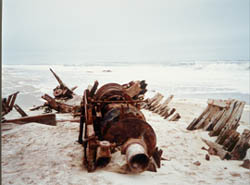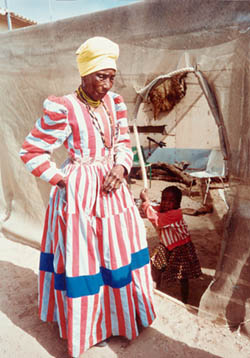Delicate Balance
Skeleton Coast,
Namibia
by Sarah Shuckburgh
On a drive along Namibia's desolate Skeleton Coast,
Sarah Shuckburgh finds that life and death are never far
from one another.
You don't want to break down on Namibia's Skeleton Coast.
Even by African standards, it is incredibly remote. My
friend Caroline and I take turns to drive, feeling like
Thelma and Louise, or perhaps two latter-day Karen Blixens.
As we listen to each clank and shudder of our hired car, we
discuss our likely demise. Dotted along hundreds of miles of
shoreline are the eerie remains of ships, their rusty iron
hulks half-covered in drifts of sand. These are not
tragedies from long ago - the graveyard coast lures vessels
to this day. Did sailors ever survive these wrecks, we
wonder? Did they hobble to the road and wait, scorched and
thirsty in the blistering sun, for the miracle of a vehicle
passing on its way to nowhere? Will anyone stumble across
our prostrate bodies before they are reduced to bleached
bones?
 The sand and gravel track, rutted and furrowed, forges north
- a wide, variegated ribbon, narrowing with each undulation
of the dunes until it disappears into shimmering desert
haze. To our left, the Atlantic thunders towards the stony
shore. To our right, as far as we can see, there is sand. The sand and gravel track, rutted and furrowed, forges north
- a wide, variegated ribbon, narrowing with each undulation
of the dunes until it disappears into shimmering desert
haze. To our left, the Atlantic thunders towards the stony
shore. To our right, as far as we can see, there is sand.
We muse that the nomadic Himbas, who still live near this
coast, must have as many words for sand as the Inuit are
said to have for snow, for this bleak and beautiful sand
glints and sparkles in a thousand shades of grey, ochre,
pink and purple. Our eyes adjust to subtle differences in
the curves and peaks of the dunes, some smooth, with elegant
knife-edge crests; some stony, rugged and ominous.
Before embarking on this drive, we spend two nights in the
genteel town of Swakopmund, a weird mixture of palm trees,
tumble-down shacks and neat Germanic architecture painted in
pastel shades. Namibia's only seaside resort attracts flocks
of Windhoek residents in the heat of December and January -
but now it has a ghostly feel. Surrounded by dusty desert,
Swakopmund's streets peter out into sand, which laps at
doorsteps and blows into heaps against walls.
After leaving Swakopmund in chilly, early morning mist, our
first stop is at a rocky promontory jutting into the ocean,
home to half a million Cape fur seals. We stand behind a low
stone wall and reel at the overpowering stench. At our feet,
seals flop and sprawl in shivering, squirming heaps,
covering every inch of rock and sand for miles along the
shore. Giant males heave their clumsy hulks over the
blubbery piles, inching towards the sea, where they flop
into the surf and are transformed into shining aquatic
virtuosi, displaying sleek, graceful swoops. The smell makes
us gag. We retreat to the car, but the sickening odour
follows us, permeating our hair and clothes for the rest of
the day.
A gate - in the middle of nowhere - marks the start of the
Skeleton Coast National Park. A barefoot child sells us key
rings carved out of palm-nuts. Nearby, a Herero woman prods
sweet potatoes in the smoky embers of a fire. Her head is
wrapped in a colourful turban, but the cut of her dress has
a familiar ring - is it 1970s' Laura Ashley, or BBC costume
drama? With its high neckline and tightly fitting bodice,
leg o'mutton sleeves with tight cuffs, and full,
ankle-length skirt, her frock is indeed of English design:
Victorian missionaries, shocked to find Herero women naked,
introduced demure clothing matching their own. Gospellers
have long since switched to jeans and trainers, but Herero
women haven't. Even in the heat of summer, they wear half a
dozen petticoats, and the only concession to the African sun
is the fabric - each dress is made up of assorted panels of
dazzlingly vibrant colours.
Our drive in the park is invariably bumpy and dusty, and
every now and then we stop the car for a break. Sometimes
the wind roars over the sand with noisy, almost animate
force. Sometimes the dunes protect us from the wind, and an
eerie calm descends as we turn off the engine. The silence
makes my ears tingle and burn, so unaccustomed am I to this
total quietness. It seems impossible that anything could
survive in this barren landscape, but here at our feet a
trio of black spiders scuttles into a hole. A few yards
away, massive leaves sprawl from a Welwitschia, a plant
that's unique to south-west Africa, and one that can live
for more than 1,000 years. A delicately embossed snake basks
at the roadside. Glossy-backed beetles plod through the
sand, leaving matching hieroglyph footprints. Swirling
mists, formed as cold winds from the ocean meet hot desert
air, provide enough moisture to sustain a multitude of
desert flora and fauna.
 After several hours, we come upon two stationary tractors.
They have been grading and flattening the road, but now
their crews are having a rest. We pull up. Not for the first
time, we become aware of two categories of time - normal and
African. We sit for a bit. We get out of the car and stretch
our legs. The men are keen to chat, but not to move. After several hours, we come upon two stationary tractors.
They have been grading and flattening the road, but now
their crews are having a rest. We pull up. Not for the first
time, we become aware of two categories of time - normal and
African. We sit for a bit. We get out of the car and stretch
our legs. The men are keen to chat, but not to move.
With our normal time mindset of schedules and deadlines, we
decide to drive round the tractors - and immediately get
stuck in the sand. The tractor men cheerfully push us out,
and on we go through the uninhabited emptiness. Mindful of
this coastline's eponymous skeletons, we agree not to try
driving off the road again.
Now the track dips down to a dry river bed. In the middle,
edged by a scattering of green shoots, a tiny stream
trickles between scorched stones. Caroline suspects that
this minuscule oasis is enough to attract wildlife, and we
settle down with binoculars.
The desert sun creates astonishing extremes of light -
illuminating an escarpment with blinding ferocity, while
casting dramatic, inky shadows and a deathly chill. We wait
in the dense silence, and hold our breath as one, then two,
springbok tiptoe out of the scrub, followed by a
spindly-legged oryx. They freeze, heads inclined towards us,
returning our steady gaze, before bending to drink. As they
step delicately away, Caroline spots a brown hyena skulking
in tall rushes.
The shadows are lengthening as we arrive at Terrace Bay, a
bleak outpost of spartan bungalows where we are to spend the
night.
Our wooden cabin, just yards from the crashing waves, is
damp and frugally furnished, and reminds me of the East
Anglian beach huts of my 1950s' childhood.
Dusk falls suddenly, and we stumble by torchlight to the
canteen, where we are served springbok stew and stale bread.
When the canteen closes at 8.30, we emerge to find an
astonishingly black sky speckled with a blanket of stars.
The desert wind has caused intransigent tangles in my hair,
which brushes are powerless to loosen. With dreadlocks
tickling my face, and the lingering aroma of half a million
seals, I am lulled to sleep by the roar of the ocean
pounding on this desolate coast.
First published by the Telegraph
©SarahShuckburgh |